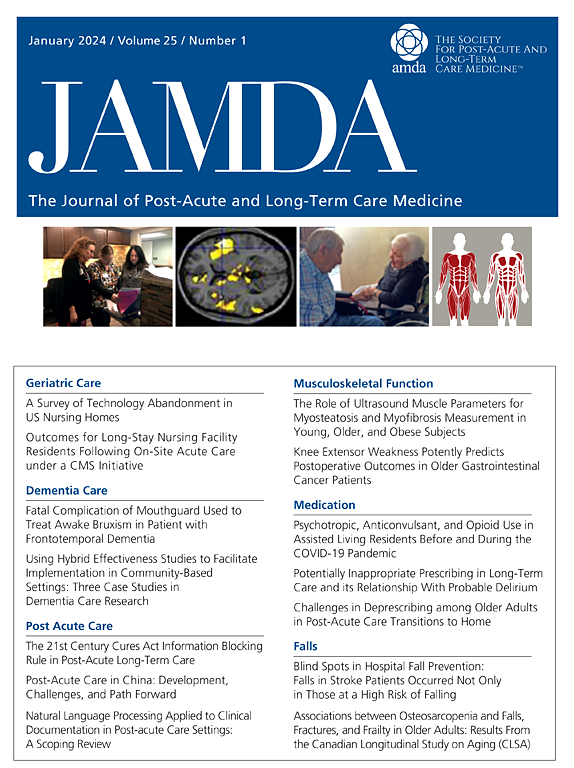美国睡眠保健服务的空间差异:基于人口的地理空间分析》。
IF 4.2
2区 医学
Q2 GERIATRICS & GERONTOLOGY
Journal of the American Medical Directors Association
Pub Date : 2024-09-21
DOI:10.1016/j.jamda.2024.105274
引用次数: 0
摘要
目的:研究美国睡眠保健服务的空间获取情况,并调查其与人口和社会经济特征之间的关联:研究美国睡眠保健的空间获取情况,并调查与人口和社会经济特征的关联,从而确定睡眠保健服务空间获取有限的高风险社区:设计:基于人口的横截面地理空间分析:设置和参与者:美国 48 个毗连州、阿拉斯加州和夏威夷州人口普查区的居民:方法:利用 2020 年美国社区调查 5 年估计数据、2010 年城乡通勤地区代码、2020 年地区贫困指数以及全国提供者识别码文件中的睡眠护理提供者位置来评估空间访问和相关人口/社会经济特征。使用增强型两步浮动集水区方法,以空间获取率来衡量空间获取情况。使用逻辑回归分析和多变量线性回归分析对相关性进行了研究:结果:共有 4580 万居民的睡眠保健空间可及性较低。在农村和地区贫困指数较高的地区,以及无保险、无车、无网络、认知困难和听力困难的人口较多的地区,空间获得性有所下降。随着少数种族(非白人)人口比例增加 10%,大都市人口普查区的空间通达性增加了(3.268%),而大都市(-1.526%)和农村(-4.493%)地区的空间通达性则下降了。在少数民族(西班牙裔或拉丁裔)人口中也观察到了类似的结果:美国各地在获得睡眠保健服务的空间上存在差异,尤其是对弱势人群而言。少数种族/族裔在城市和农村地区表现出截然不同的空间获取模式,农村地区的少数种族/族裔在睡眠保健的空间获取方面面临更多挑战。本文章由计算机程序翻译,如有差异,请以英文原文为准。
Disparities in Spatial Access to Sleep Health Care in the United States: A Population-Based Geospatial Analysis
Objectives
To examine spatial access to sleep health care in the United States and investigate associations with demographic and socioeconomic characteristics, thereby identifying high-risk communities with limited spatial access to sleep health service.
Design
A cross-sectional population-based geospatial analysis.
Settings and Participants
Residents in US Census tracts across the 48 contiguous states, Alaska, and Hawaii.
Methods
The 2020 American Community Survey 5-year estimates, 2010 rural-urban commuting area codes, 2020 Area Deprivation Index, and sleep care provider locations from the National Provider Identifier file were used to assess the spatial access and related demographic/socioeconomic characteristics. Spatial access was measured by spatial access ratio using enhanced 2-step floating catchment area methods. The associations were investigated using logistic regression analysis and multivariate linear regression analysis.
Results
A total of 45.8 million residents experienced low spatial access to sleep health care. Spatial access decreased in rural and high Area Deprivation Index areas, and in areas characterized by higher population with uninsured status, vehicle unavailability, internet unavailability, cognitive difficulties, and hearing difficulties. With a 10% increase in the percentage of the racial minority (non-white) population, metropolitan census tracts experienced an increase in spatial access (3.268%), whereas micropolitan (−1.526%) and rural (−4.493%) areas experienced a decrease in spatial access. Similar findings were observed within the ethnic minority (Hispanic or Latino) population.
Conclusions and Implications
Disparities exist in spatial access to sleep health care across the United States, especially for disadvantaged individuals. Racial/ethnic minorities exhibit contrasting spatial access patterns in urban and rural areas, with those in rural areas facing more challenges in spatial access to sleep health care.
求助全文
通过发布文献求助,成功后即可免费获取论文全文。
去求助
来源期刊
CiteScore
11.10
自引率
6.60%
发文量
472
审稿时长
44 days
期刊介绍:
JAMDA, the official journal of AMDA - The Society for Post-Acute and Long-Term Care Medicine, is a leading peer-reviewed publication that offers practical information and research geared towards healthcare professionals in the post-acute and long-term care fields. It is also a valuable resource for policy-makers, organizational leaders, educators, and advocates.
The journal provides essential information for various healthcare professionals such as medical directors, attending physicians, nurses, consultant pharmacists, geriatric psychiatrists, nurse practitioners, physician assistants, physical and occupational therapists, social workers, and others involved in providing, overseeing, and promoting quality

 求助内容:
求助内容: 应助结果提醒方式:
应助结果提醒方式:


